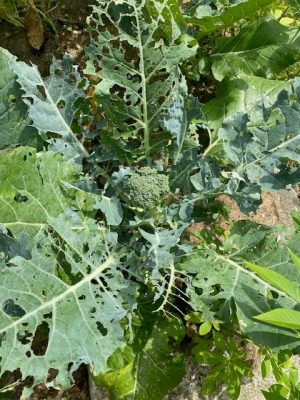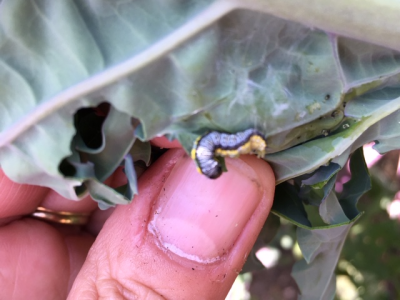By Dawn Pettinelli, UConn Home & Garden Education Center
Broccoli, cabbage, kale and other members of the brassica family are tasty and so good for you but its not just us who find them delectable. Brassicas have a number of insect pests but probably several caterpillar species do the most damage.

When checking plants, look for holes in the leaves. A few irregular holes may soon become a skeletonized leaf with only the midrib left if control measures are not taken. These caterpillars can quickly devour plants.
Two of the most common pests are the imported cabbageworm and the cross striped cabbage worm. According to Dr. Shuresh Ghimire, UConn Vegetable Extension Specialist, imported cabbageworm is the offspring of the cabbage butterfly, a butterfly with white wings with 1-2 round black spots on the forewing. Eggs, laid singly on leaves, are light green or yellow and slightly elongated. Three to 5 days later, the eggs hatch. The lime green velvety caterpillars feed for 2 to 3 weeks.
Dr. Ghimire noted that imported cabbage worm feeding and resting mostly occur on the underside of leaves. Be sure to check both the tops and bottoms of leaves. Damage includes round or ragged feeding holes and deposits of wet, green or brownish frass. There can be 4 to 5 generations each year. This pest overwinters as a pupae close to host plants.

The cross-striped cabbageworm used to be a southern pest but no longer. The adult moths fly at night so are seldom seen. Cross-striped cabbageworms are most abundant on late-season plantings says Dr. Ghimire. Unlike the other major caterpillar pests, such as cabbageworm and diamondback moth, the cross-striped cabbageworm lays its eggs in batches (3-25) rather than singly, so caterpillars emerge in clusters. Egg batches are yellow, flattened, overlapping like fish scales, and attached to the lower leaf surfaces.
The distinctive-looking caterpillars are bluish gray on top with green on their undersides, a yellow stripe on each side with a row of numerous black bands across the back. Clusters of these caterpillars are voracious feeders and plants infested with cross-striped cabbageworm larvae are often completely skeletonized, while adjacent plants may be left undamaged. There are 2 or 3 generations per year.
Two other caterpillar pests of brassicas are the diamondback moth and the cabbage looper. Eggs of these two pests are laid singly and most years they do not cause considerable damage to home vegetable gardens.
There are several strategies to control these caterpillars on broccoli plants. If you have just a few plants, check them every few days looking at both sides of the leaves and either squish any caterpillars you find or drop them into a can of soapy water.

Rotating your plantings and interplanting with flowers may confuse pests. Dr. Ghimire suggests planting flowers to attract natural enemies, like Braconid wasps, which lay eggs on soft-bodied caterpillars such as cabbage worms. The larvae feed inside the live caterpillars, weakening or killing them. Some plants known to attract pest predators include dill, parsley, hyssop and mints.
Since brassicas do not need to be pollinated, they can be covered with netting or row covers to exclude insect pests. The holes in the netting should be one-quarter inch. Hoops can be used to hold up the barrier or one can make wooden or PVC cages for a custom fit. Be sure to tuck or pin the edges to the soil so pests can’t crawl under.
Finally, if the caterpillar infestation becomes too extensive, Dr. Ghimire recommends Bacillus thuringiensis (Bt), which is a biological control for Lepidoptera species of moths and butterflies. Bt is a bacterium that when sprayed on your plants and consumed by the caterpillar enters the insect’s gut and causes it to die. While it is effective for controlling these pests, it is harmless to humans and other animal species. Limit its use to brassicas to prevent it from affecting desirable caterpillars.
As with all garden pests, the key to healthy plants is regular monitoring and putting control measures into practice when pests are first noticed. For questions on brassica pests or any other gardening questions, feel free to contact us, toll-free, at the UConn Home & Garden Education Center at (877) 486-6271, visit our website at www.homegarden.cahnr.uconn.edu